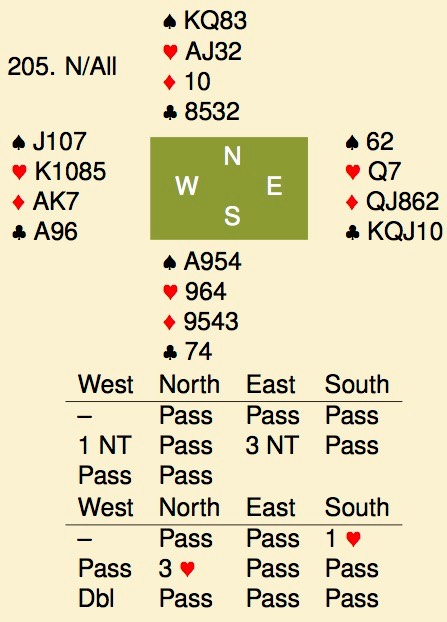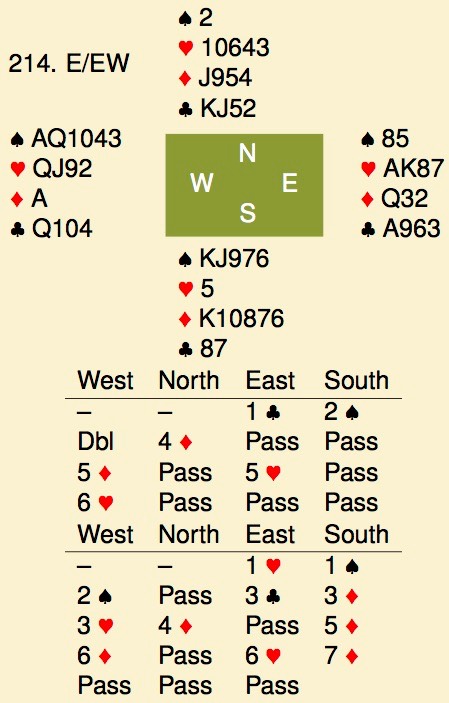Time to wrap up this analysis. When we left this match, Italy was leading by some 9500 points with 48 boards left to be played. A few more blows put the match out of reach for the US team.

In the open room, a routine 3NT was bid (1NT nominally 16-18 by west, 3NT by east) D’Alelio for Italy led a heart rather than a spade, which I think is a rather interesting choice. To set the contract, partner must have a high honor in the major you lead, but a heart lead is much more likely to cost a trick if partner doesn’t. Here the ♥2 led ran to the ♥10, setting up a potential second heart trick for declarer. Of course, declarer never came to that trick, he simply took his 9 minor suit winners for an overtrick. At the table, I would not be too happy with -630 on this board.
In the closed room however, we see the third psyche by Boris Koytchou in this match. All vulnerable (sic!), 3rd hand, he decided to open 1♥ on his 1 ace wonder. Unfortunately, he found partner with 4 card support, a 10 count, and a normal raise to 3♥. Belladonna had seen these openers before, first passed 1♥ then doubled for penalties. The ♦A was led. followed by the ♥10, ♥J, ♥Q and a heart back. That led to down 4. Somehow declarer can always make 5 tricks (3 spades, ♥A and a diamond ruff) here. 1100 and 470 to Italy.
Note that bidding 1♠ instead of 1♥ would have saved the Americans a lot of points. North presumably has a 3♠ bid. That is much harder for EW to double and declarer 6 tricks there. And if the Italians bid 3NT, I’m sure north will lead a spade.

While the bidding by both sides can be considered primitive by 2017 standards, the Italian bidding was clearly better. Here we see a toy that the Americans did not have in their bag: a conventional bid to show a 2-suiter. The 2_ overcall was a so-called Roman Jump Overcall, showing 5-5 in spades and the next higher suit. After the penalty double, north preempted in the other suit and it was up to EW to find the right spot and level. They somehow succeeded though 5♦ looks very risky to me, if there is no fit, you can easily get overboard, but then there was the play.
With the adverse bidding, the hand can almost be played double dummy. South has 5-5 in 2 suits, the ♠K appears to be onside and hearts 4-1 won’t be much of a surprise either. Nevertheless, the US declarer failed to take advantage of all this.
♦6 led to the ♦A. ♥2 to the ♥A. At this point, declarer must start on the spades by leading towards the ♠AQ10. Dummy wins, the ♥Q confirms the bad split and declarer can start on clubs. ♣Q ducked, even if north covers. At this point, there is nothing north can do. Impossible to find, I don’t think so considering that NS have given a blueprint to the hand. In practice, declarer led a heart to the ♥Q in trick 2, making it impossible to take 2 spade finesses in due course and thus ending up down 1.
In the replay, south did not have a tool to show a weak 2 suiters and had to bid her suits naturally. The 1♥ opener had already ensured that the fit was found and 6♥ was reached as well. Forguet would have had pretty much the same information about the hand if he’d had to play 6♥ but we’ll never if he would have used that to his advantage, that as west saved in 7♦. That went down 6, for -1100 in the 1957 scoring (today, it would be 1400).
The match ended after 214 boards with a 10030 point victory for the Italians, winning them their first Bermuda Bowl on their second attempt (the first one was in 1951) and the start of a series of 10 victories in the years after that. To put the score into perspective, it would have been 639-445 in today’s imps, or almost 1 imp per board more. That is a lot.
Having reviewed all the boards, there are several reasons for this loss. First, the Italians fielded 3 fixed partnerships, where the Americans essentially drew for partners for each session and 9 out of the 15 possible combinations of the 6 players, played as a partnership. Even though all players used “standard american” bidding, individual differences led to misunderstandings. It would take several years before the US realized that fixed partnerships are the way to go. Second, even though they were primitive by today’s standards, the Italian systems looked to be much more developped than the American counterparts. And, judging from the auctions, it does not appear that the Americans had prepared to play against these systems. Finally, we have seen a few nice examples of Italian declarer play, winning huge numbers of points. And if things went wrong, at least they looked sensible.
Time to go back to 2017.
